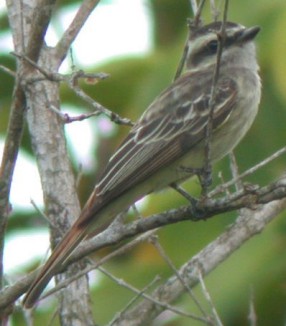PHOTO GALLERY




| SOUTHEASTERN CARIBBEAN BIRDS PHOTO GALLERY |
||||||||||||||||||||||
| Trinidad and Tobago Field Naturalists' Club Southeastern Caribbean Bird Alert Trinidad and Tobago Rare Bird Committee |
||||||||||||||||||||||
| TRINIDAD AND TOBAGO | ||||||||||||||||||||||
| Variegated Flycatcher (Empidonomus varius) | ||||||||||||||||||||||
 |
||||||||||||||||||||||
 |
 |
|||||||||||||||||||||
| Immature at Asa Wright Nature Centre, Trinidad, 18 November 2001. Photos © by Rose Ann Rowlett. Two individuals were noted at the time, but were not seen subsequently. Several features of this individual distinguish it from the similar Piratic Flycatcher (Legatus leucophaius), including the longer bill, pale base of the mandible (entirely dark in Piratic), a wide and distinct lateral throat stripe (narrower and less distinct in Piratic), broad, whitish edges to most of the median, greater, and a few lesser wing coverts (narrower and greyish or brown in Piratic), extensive rufous on the uppertail coverts and the dark centres reduced to a narrow shaft-streak (uppertail coverts broadly dark with rufous only at the very edges of the feathers, if any at all, in Piratic), more extensive rufous edging on the outer web edges of the bases of the rectrices (less extensive in Piratic), and a relatively long tail with more than 2/3 of it protruding beyond the wingtips (only about 1/2 protruding past wingtips in shorter-tailed Piratic). The moulting wing (and perhaps tail) feathers, combined with the brown crown without any obvious mottling nor any hint of a yellow central crown spot (although crown spots are often totally concealed) suggests a bird moulting from first-basic to first-alternate plumage. The sparse streaking of the underparts, combined with the moult schedule, suggest that this individual represents rufinus of northern South America rather than highly migratory, nominate varius of southern South America. | ||||||||||||||||||||||
 |
||||||||||||||||||||||
| Adult at Arena Forest, Trinidad, 16 January 2003. Photo © by Mike Roger. The bird was seen again on 17 January. Note the blacker crown of this individual compared with the bird in the photos above, indicative of an adult. The sparse streaking of the underparts suggests that this individual represents of rufinus. | ||||||||||||||||||||||